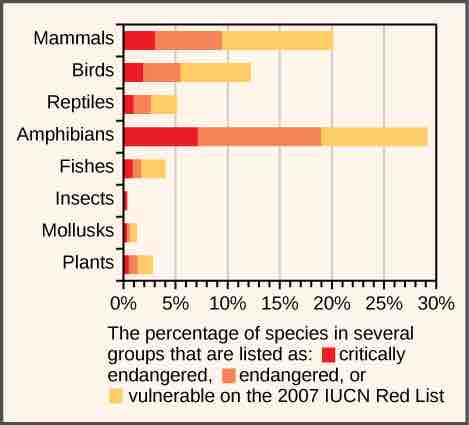Measuring Biodiversity
The technologies of molecular genetics, data processing, and data storage are maturing to the point where cataloging the planet's species in an accessible way is close to feasible. DNA barcoding is one molecular genetic method, which takes advantage of the rapid evolution in a mitochondrial gene present in eukaryotes, to identify species using the sequence of portions of the gene. Plants may be barcoded using a combination of chloroplast genes.
DNA Barcoding
DNA barcoding is a taxonomic method that uses a short genetic marker in an organism's DNA to identify it as belonging to a particular species. It differs from molecular phylogeny in that the main goal is not to determine patterns of relationship, but to identify an unknown sample in terms of a preexisting classification. The most commonly-used barcode region for animals, at least, is a segment of approximately 600 base pairs of the mitochondrial gene cytochrome oxidase I (COI).
Applications include, for example, identifying plant leaves (even when flowers or fruit are not available), identifying insect larvae (which may have fewer diagnostic characters than adults and are frequently less well-known), identifying the diet of an animal (based on its stomach contents or feces), and identifying products in commerce (for example, herbal supplements or wood).
Rapid, mass-sequencing machines make the molecular genetics portion of the work relatively inexpensive and quick. Computer resources store and make available the large volumes of data. Projects are currently underway to use DNA barcoding to catalog museum specimens, which have already been named and studied, as well as testing the method on less studied groups. As of mid-2012, close to 150,000 named species had been barcoded. Early studies suggest there are significant numbers of undescribed species that looked too much like sibling species to previously be recognized as different. These now can be identified with DNA barcoding.
Numerous computer databases now provide information about named species and a framework for adding new species. However, as already noted, at the present rate of description of new species, it will take close to 500 years before the complete catalog of life is known. Many, perhaps most, species on the planet do not have that much time.
There is also the problem of understanding which species known to science are threatened and to what degree they are threatened. This task is carried out by the non-profit IUCN (International Union for Conservation of Nature) which maintains the Red List: an online listing of endangered species categorized by taxonomy, type of threat, and other criteria . The Red List is supported by scientific research. In 2011, the list contained 61,000 species, all with supporting documentation.

IUCN Red List
This chart shows the percentage of various animal species, by group, on the IUCN Red List as of 2007. The Red List is an online listing of endangered species categorized by taxonomy, type of threat, and other criteria.